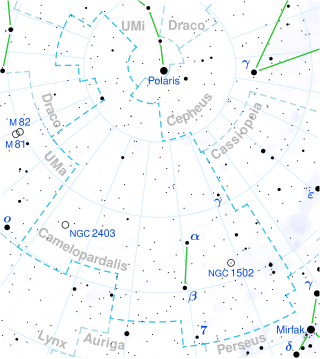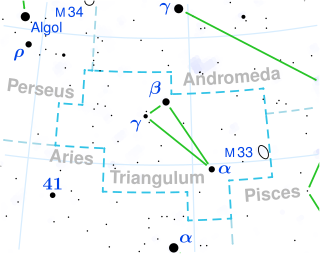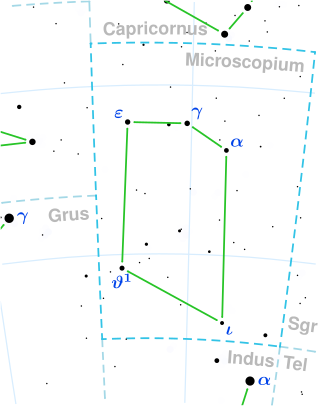
λ Telescopii, Latinized as Lambda Telescopii, is a solitary, bluish-white hued star located in the southern constellation of Telescopium. It has an apparent magnitude of 4.84, making it readily visible to the naked eye under ideal conditions. Gaia DR3 parallax measurements imply a distance of 490 light years, and it is currently approaching the Solar System with a somewhat constrained heliocentric radial velocity of −2 km/s. At its current distance, the visual magnitude of Lambda Telescopii is diminished by an extinction of 0.25 due to interstellar dust and it has an absolute magnitude of −1.51.

HD 27245, also known as HR 1335 or rarely 25 H. Camelopardalis is a solitary red-hued star located in the northern circumpolar constellation Camelopardalis. It has an apparent magnitude of 5.4, making it faintly visible to the naked eye. Gaia DR3 Parallax measurements place it approximately 607 light years away from it the Solar System and is drifting further away with a heliocentric radial velocity of 25.2 km/s. At its current distance, HD 27245's brightness is diminished by 0.36 magnitudes due to extinction from interstellar dust. It has an absolute magnitude of −0.27.
HD 27274, also known as Gliese 167, is a solitary, orange hued star located in the southern constellation Dorado. It has an apparent magnitude of 7.63, making it readily visible in binoculars, but not to the naked eye. Based on parallax measurements from the Gaia spacecraft, the star is known to be located 42.5 light-years away from the Solar System However, it is drifting closer with a heliocentric radial velocity of −23 km/s. At its current distance, HD 27274 is dimmed down by 0.05 magnitudes due to interstellar dust.

HD 24479, also designated as HR 1204, is a solitary, bluish-white hued star located in the northern circumpolar constellation Camelopardalis. The star is visible to the naked eye with an apparent visual magnitude of 5.04. Based on Gaia DR3 parallax measurements, it is located 385 light years from the Sun. However, it is receding with a somewhat constrained heliocentric radial velocity of 4.6 km/s. At its current distance, HD 24479's brightness is diminished by 0.29 magnitudes due to interstellar dust.

N Scorpii, also known as HD 148703, is a solitary, bluish-white hued star located in the southern constellation Scorpius. It has an apparent magnitude of 4.23, making it readily visible to the naked eye. N Scorpii was initially given the Bayer designation Alpha Normae by Lacaille but it was later moved from Norma to Scorpius. N Scorpii is currently located 550 light years away based on parallax measurements from the Hipparcos satellite and is part of the Upper Scorpius–Centaurus region of the Scorpius–Centaurus association.
HD 63399 is an orange hued star located in the southern constellation Puppis, the poop deck. It has an apparent magnitude of 6.45, placing it near the limit for naked eye visibility. Based on parallax measurements from Gaia DR3, the object is estimated to be 445 light years distant. It appears to be receding with a spectroscopic radial velocity of 28.5 km/s. At its current distance, HD 63399 is diminished by 0.29 magnitudes due to interstellar dust.

S Apodis, also known as HD 133444 is a variable star located in the southern circumpolar constellation Apus. It has an apparent magnitude ranging from 9.6 to 17, which is below the limit for naked eye visibility. The object is located relatively far at a distance of approximately 15,000 light years based on Gaia DR3 parallax measurements, but it is drifting closer with a heliocentric radial velocity of −75 km/s.

HD 57197, also known as M Puppis or HR 2789, is a suspected astrometric binary located in the southern constellation Puppis, the poop deck. It has an apparent magnitude of 5.84, making it faintly visible to the naked eye under ideal conditions. Based on parallax measurements from the Gaia satellite, the system is estimated to be 629 light years away from the Solar System. The value is poorly constrained, but it appears to be receding with a heliocentric radial velocity of 13 km/s. At its current distance, HD 57197's brightness is diminished by 0.3 magnitudes due to interstellar dust. It has an absolute magnitude of -0.43.

HD 76236, also designated as HR 3543 or rarely 11 G. Chamaeleontis, is a solitary star located in the southern circumpolar constellation Chamaeleon. It is faintly visible to the naked eye as an orange-hued star with an apparent magnitude of 5.77. Based on parallax measurements from the Gaia satellite, the object is estimated to be 612 light years away. Currently, it is receding with a heliocentric radial velocity of 7 km/s. At its current distance, HD 76236's brightness is diminished by 0.39 magnitudes due to interstellar dust. It has an absolute magnitude of −0.13.

14 Trianguli, also known as HD 15656, is a spectroscopic binary located in the northern constellation Triangulum. It has an apparent magnitude of 5.14, making it faintly visible to the naked eye in ideal conditions. Gaia DR3 parallax measurements place the system 433 light years away, and it is currently approaching the Solar System with a heliocentric radial velocity of −37 km/s. At its current distance, 14 Tri's brightness is diminished by 0.21 magnitude due to interstellar dust. It has an absolute magnitude of −0.46.
HD 89571 is a binary star located in the northern circumpolar constellation Camelopardalis. It is faintly visible to the naked eye with a combined apparent magnitude of 5.51 and is estimated to be 142 light years away from the Solar System. However, it is receding with a heliocentric radial velocity of 3.5 km/s.
HD 34255, also known HR 1720, is a star located in the northern circumpolar constellation Camelopardalis, the giraffe. It has an apparent magnitude of 5.60, allowing it to be faintly visible to the naked eye. The object is located relatively far at a distance of about 1.65 kly but is approaching the Solar System with a heliocentric radial velocity of −7.7 km/s.
HD 115088, also known as HIP 64951, is a star located in the southern circumpolar constellation Chamaeleon. It has an apparent magnitude of 6.33, placing it near the limit for naked eye visibility. Based on parallax measurements from the Gaia spacecraft, the object is estimated to be 412 light years distant. At that distance, its brightness is diminished by 0.37 magnitudes due to interstellar dust.
HD 50885, also known as HR 2581, is a star located in the northern circumpolar constellation Camelopardalis, the giraffe. It has an apparent magnitude of 5.69, making it faintly visible to the naked eye if viewed under ideal conditions. Based on parallax measurements from Gaia DR3, the object is estimated to be 513 light years distant. It appears to be approaching the Solar System with a heliocentric radial velocity of −17.8 km/s.
HD 43899, also designated as HR 2263, is a solitary, orange hued star located in the southern constellation Columba, the dove. It has an apparent magnitude of 5.53, allowing it to be faintly visible to the naked eye. Based on parallax measurements from the Gaia spacecraft, the object is estimated to be 284 light years distant. It appears to be rapidly receding with a heliocentric radial velocity of 66.5 km/s. Eggen (1993) lists HD 43899 as an old disk star and its kinematics match with that of the ζ Herculis moving group.

HD 201772, also known as HR 8104, is a yellowish-white hued star located in the southern constellation Microscopium. It has an apparent magnitude of 5.26, making it one of the brighter members of this generally faint constellation. The object is located relatively close at a distance of 111 light-years based on Gaia DR3 parallax measurements but is approaching closer with a heliocentric radial velocity of −41 km/s. At its current distance, HD 201772's brightness is diminished by 0.11 magnitudes due to interstellar dust.

HD 117566, also known as HR 5091, is a solitary yellow-hued star located in the northern circumpolar constellation Camelopardalis. It has an apparent magnitude of 5.74, making it faintly visible to the naked eye. This object is relatively close at a distance of 291 light years based on Gaia DR3 parallax measurements but is receding with a heliocentric radial velocity of 14 km/s. At its current distance, HD 117566's brightness is diminished by 0.12 magnitudes due to interstellar dust.

HD 197630, also known as HR 7933 or rarely 23 G. Microscopii, is a probable astrometric binary located in the southern constellation Microscopium. The visible component is a bluish-white hued star that is faintly visible to the naked eye with an apparent magnitude of 5.47. Based on parallax measurements from the Gaia satellite, the system is estimated to be 328 light years away. However, it is drifting closer with a heliocentric radial velocity of −30 km/s. At its current distance, HD 197630's brightness is diminished by 0.11 magnitudes due to interstellar dust. A 2012 multiplicity survey failed to confirm the velocity variations.

HD 170642, also designated as HR 6942 or rarely 13 G. Coronae Australis, is a single star located in the southern constellation Corona Australis. It is faintly visible to the naked eye as a white hued star with an apparent magnitude of 5.16. The object is located relatively close at a distance of 229 light years based on Hipparcos parallax measurements, but it is approaching the Solar System with a somewhat constrained heliocentric radial velocity of −6 km/s. At its current distance, HD 170642's brightness is diminished by 0.28 magnitudes due to interstellar dust. It has an absolute magnitude of +0.93.

HD 174474, also designated as HR 7095 or rarely 35 G. Telescopii, is a solitary white-hued star located in the southern constellation Telescopium. It has an apparent magnitude of 6.17, placing it near the limit for naked eye visibility. The object is located relatively close at a distance of 244 light years based on Gaia DR3 parallax measurements but is drifting closer with a heliocentric radial velocity of −44 km/s. At its current distance, HD 174474's brightness is diminished by 0.26 magnitudes due to interstellar dust. It has an absolute magnitude of +1.61.










